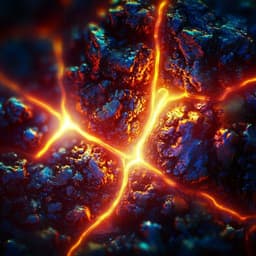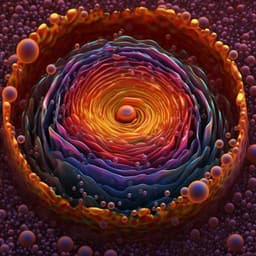
Physics
Observation of reentrant metal-insulator transition in a random-dimer disordered SSH lattice
Z. Xu, J. Gao, et al.
Discover groundbreaking insights into reentrant localization transitions in photonic SSH lattices with random-dimer disorder! This pioneering research by Ze-Sheng Xu, Jun Gao, Adrian Iovan, Ivan M. Khaymovich, Val Zwiller, and Ali W. Elshaari uncovers how certain eigenstates can exhibit extended behavior post an initial localization transition, enriching our understanding of transport in disordered media.
~3 min • Beginner • English
Introduction
Since the pioneering work of Rolf Landauer and Philip W. Anderson, wave function localization in disordered media has been extensively investigated to understand quantum phase transitions and transport physics. Anderson localization predicts the absence of diffusion due to interference in disordered potentials, and increasing disorder suppresses transport, leading to a metal-insulator transition. In low-dimensional systems with uncorrelated disorder (D ≤ 2), all eigenstates become localized irrespective of disorder amplitude. In contrast, quasiperiodic potentials can exhibit a finite critical disorder separating metallic and insulating phases with an intermediate regime where extended and localized states coexist, characterized by single-particle mobility edges (at least at finite sizes). Contrary to the traditional view of a monotonic transition from extended to localized states with increasing disorder, recent theory has shown that reentrant localization can occur in a Su-Schrieffer-Heeger (SSH) chain with staggered quasiperiodic or random-dimer disorder. As disorder is increased, the system transitions from extended to localized, then re-extends for a subset of states (coexistence regime), and finally relocalizes at even higher disorder. This work experimentally investigates and demonstrates such reentrant localization in a one-dimensional photonic SSH lattice with random-dimer correlated disorder.
Literature Review
Classical studies on disordered systems established Anderson localization and the suppression of quantum transport with increasing disorder (Landauer; Anderson; Lee and Ramakrishnan). Experimental observations span electronic, photonic, acoustic, and ultracold atomic systems. In one dimension with uncorrelated disorder, all states localize for any nonzero disorder (Abrahams et al.). Quasiperiodic models such as Aubry-André and generalizations demonstrate finite critical disorder and mobility edges (Aubry and André; Ganeshan et al.; Lüschen et al.; Biddle and Das Sarma; Li and Das Sarma; Wang et al.). Beyond quasiperiodicity, short-range correlated disorder can also yield coexistence of localized and extended states without a clear mobility edge (Das and Ghosh). For dimerized lattices, theory predicted reentrant localization transitions in SSH chains with quasiperiodic or random-dimer disorder (Roy et al.; Zuo and Kang), motivating an experimental test. Photonic platforms, including integrated waveguide arrays, have emerged as powerful simulators of disordered quantum systems and topological phases, enabling direct observation of transport, localization, and band-structure effects.
Methodology
Model: A one-dimensional SSH lattice with N sites (N/2 unit cells of two sites) is implemented with nearest-neighbor hopping amplitudes t(1 ± Δ), where Δ is the dimerization parameter controlling intra- and inter-cell couplings. Correlated on-site random-dimer disorder is introduced via a bimodal on-site potential εi that takes value ε with probability p on dimers (random-dimer assignment) and zero otherwise. Transport regimes are probed by sweeping ε. Localization is quantified using the inverse participation ratio (IPR) and normalized participation ratio (NPR) computed from eigenstates ψn,i over sites i: IPRn = Σi |ψn,i|^4 and NPRn = (Σi |ψn,i|^2)^2 / (N Σi |ψn,i|^4) or, equivalently for the reported analysis, the spectral averages (IPR) = (1/N) Σn IPRn and (NPR) = (1/N) Σn NPRn across the spectrum. A diagnostic parameter η = log10[(IPR) × (NPR)] is used to identify coexistence regions where both averages are non-zero. Numerical simulations: Spectra and NPR are computed for large lattices (up to 1000 sites) to resolve band structure and participation metrics under varying ε, t, Δ, and p. Theoretical analysis shows four bands centered around Ev = εv ± t(1 + Δ) for v = 0, 1 with bandwidth 2 t (1 − Δ), and gap closing/reopening as ε is tuned leads to delocalization at band crossings. Coupled-mode theory simulations model light evolution for single-site excitations in 100-site lattices over 1000 µm propagation for ε = 0, 0.1, 0.185, 0.3 (p = 0.5), exciting the 41st site. Experimental platform: A Si3N4 (silicon nitride) waveguide array is fabricated using electron beam lithography and reactive ion etching. Inter-waveguide spacing sets the nearest-neighbor couplings t(1 ± Δ). On-site potentials are synthetically engineered by tailoring individual waveguide widths to realize the random-dimer ε pattern with probability p. The lattice is operated in the topologically trivial phase with parameters t = 0.08 (arbitrary units), Δ = 0.25, corresponding to intra-cell and inter-cell couplings of 0.1 and 0.06, respectively, and N = 100 sites for experiments. Measurement: A 786 nm continuous-wave laser is injected via a lensed fiber. A Y-splitter and polarization controller, together with a polarizing beam splitter, are used to excite the TE mode and optimize coupling. Light propagates along the array and scatters at the output facet. A microscope objective and CCD camera image the output facet. A reference image establishes site coordinates, enabling extraction of site-resolved intensity distributions. Single-site excitation is performed at site 41. From the output intensity distributions, the NPR for single-site excitation is retrieved and compared against numerical predictions. Phase diagrams of η are computed in the (Δ, ε) and (p, ε) planes for a 100-site lattice to identify reentrant localization regions and guide experimental sampling points.
Key Findings
• First experimental observation of reentrant localization in a one-dimensional correlated-disorder system: a photonic SSH lattice with random-dimer on-site potentials. • Direct imaging of single-site-excited wavepacket dynamics reveals four regimes as ε increases (p = 0.5, Δ = 0.25): I (ε = 0) ballistic spread without disorder; II (ε = 0.1) localized transport; III (ε = 0.185) coexistence where part of the wavepacket remains localized while another part spreads ballistically; IV (ε = 0.3) re-localization, demonstrating a reentrant metal-insulator transition. • Spectral-averaged NPR versus ε exhibits a non-monotonic dependence with anomalous reentrant peaks that persist as system size increases from 30 to 1000 sites, consistent with the coexistence regime. • Band-structure analysis shows gap closing and reopening of the middle subbands as ε is swept. Near the crossing of the two middle bands, the effective disorder vanishes for a band pair, producing a disorder-free sector with delocalized states while the other bands remain localized; this mechanism underlies the reentrant delocalization. • Numerical phase diagrams using η = log10[(IPR) × (NPR)] identify regions of simultaneous non-zero (IPR) and (NPR), evidencing coexistence of extended and localized states and validating reentrant localization for a 100-site random-dimer SSH lattice. • The reentrant region’s near-vertical boundary in the (ε, p) plane indicates that the critical ε values are robust across a wide range of on-site probabilities 0.15 < p < 0.8. • Experimental measurements of output intensity distributions at 1000 µm propagation for the 41st-site excitation agree with coupled-mode simulations for ε = 0, 0.1, 0.185, 0.3. • Parameter set used in experiments: N = 100 sites, t = 0.08, Δ = 0.25 (intra/inter-cell couplings 0.1 and 0.06), random-dimer assignment probability p = 0.5.
Discussion
The study addresses whether correlated disorder in a dimerized one-dimensional lattice can induce a non-monotonic, reentrant metal-insulator transition. By combining spectral metrics (NPR, IPR, and η) with directly imaged wavepacket dynamics, the results confirm that as the on-site random-dimer potential increases, the system transitions from extended to localized, then re-extends for a subset of states (coexistence), and finally re-localizes at higher disorder. The observed NPR drop and subsequent increase provide a clear experimental signature of this non-monotonic behavior. The mechanism is linked to the closing and reopening of the gap between middle bands; at band crossings the effective disorder for a band pair vanishes, generating a delocalized, disorder-free subspace coexisting with localized states in other bands. This experimentally validates theoretical predictions of reentrant localization in SSH chains with correlated disorder, advances understanding of transport in low-dimensional disordered systems, and highlights integrated photonics as a controllable platform to simulate complex condensed matter phenomena.
Conclusion
This work reports the first experimental observation of reentrant localization in a one-dimensional random-dimer disordered SSH lattice implemented on a Si3N4 photonic platform. By engineering synthetic on-site potentials via waveguide width control and monitoring single-site-excited transport through edge-scattered imaging, the authors retrieve NPR and identify a non-monotonic metal-insulator transition with a coexistence regime. Numerical analyses (spectra, NPR/IPR, and η-based phase diagrams) explain the reentrant behavior via band crossings that produce a disorder-free sector. These results deepen the understanding of disorder-induced transitions and demonstrate the utility of integrated nanophotonics for exploring complex transport and topological phenomena. Potential future directions include quantitative mapping of mobility edges and coexistence across broader parameter spaces, exploring different correlation patterns and disorder statistics, and leveraging reentrant localization for on-chip information encoding and photonic quantum technologies.
Limitations
Related Publications
Explore these studies to deepen your understanding of the subject.







